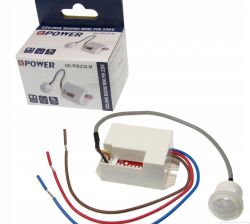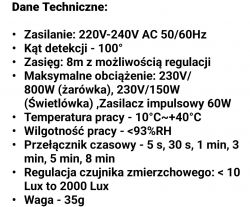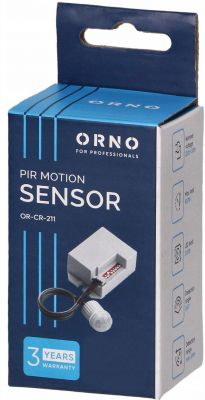FAQ
TL;DR: 15 W total (five 3 W LEDs) still made PIR stair sensors stick; "A whole 15 watts." Use a quality sensor or add a 230 V relay to handle inrush and prevent welded contacts. For homeowners and electricians fixing LED stair lights that stay on. [Elektroda, metalMANiu, post #21232824]
Why it matters: It shows how to stop stuck‑on stair lights and choose gear that won’t fail.
Quick Facts
- Connected load here is 5 × 3 W LED lamps ≈ 15 W total. [Elektroda, metalMANiu, post #21232824]
- Fault shows up after 2–3 lamps are connected; lights then won’t turn off. [Elektroda, zbyszekoziol, post #21232778]
- LED drivers can draw approx. 10–20× nominal current for milliseconds at switch‑on (inrush). [Tridonic, 2017]
- Offload the PIR with an external 230 V coil relay (e.g., Relpol on a base). [Elektroda, HD-VIDEO, post #21241404]
- One‑lamp test worked, indicating the issue scales with the number of LED drivers. [Elektroda, zbyszekoziol, post #21241103]
Why do my PIR AC stair sensors keep the LED lights on?
Undersized or low‑quality internal relays can weld their contacts from LED inrush. Once welded, the lights stay on. As one expert put it, "Welded contacts with more lamps = poor quality relays." Offload switching or replace the sensor. [Elektroda, HD-VIDEO, post #21241404]
Is 15 W of LED load really a problem for a PIR sensor?
The continuous load is small, but the issue is inrush, not watts. With poor relays, even 15 W across five lamps can trigger failures. "A whole 15 watts" highlights that wattage alone isn’t the culprit. Choose better hardware or return it. [Elektroda, metalMANiu, post #21232824]
Why does the problem appear after adding two or three lamps?
Each extra LED driver adds to the total inrush at switch‑on. The OP noted the sensors hang after two to three lamps, then the lights never go off. That pattern points to cumulative surge, not steady power. [Elektroda, zbyszekoziol, post #21232778]
Will a one‑lamp test tell me if inrush is the issue?
Yes. With a single lamp, the sensor worked. That suggests the sensor only fails when multiple drivers switch together. It’s a strong indicator of inrush stressing the contacts. [Elektroda, zbyszekoziol, post #21241103]
How do I fix this without changing all lamps?
Add an external 230 V coil relay to offload switching. 1. Wire the PIR sensor output to the relay coil. 2. Switch the lamp group with the relay contacts. 3. Mount neatly and test with all lamps connected. [Elektroda, HD-VIDEO, post #21241404]
Is "too much voltage at startup" a real cause with LEDs?
Yes. LED control gear can draw 10–20 times nominal current for a few milliseconds at power‑up. That inrush can weld undersized mechanical contacts. Pick components with inrush‑capable ratings. [Tridonic, 2017]
Should I return or replace the PIR sensors?
If a sensor needs a contactor to switch only 15 W, it’s likely faulty or poor quality. Returning it is reasonable. A sensor designed for fine lighting should handle this load unassisted. [Elektroda, metalMANiu, post #21232824]
Can I repair the existing unit by replacing its internal relay?
Possibly. Open the sensor and check which relay it uses. You may replace it with a better relay if space and coil voltage match. This is for skilled hands only. [Elektroda, HD-VIDEO, post #21241404]
What external relay type is recommended here?
Use a 230 V coil relay on a base to offload the PIR’s contacts. Relpol models are a common choice for such retrofits. Ensure contact ratings exceed your lighting load. [Elektroda, HD-VIDEO, post #21241404]
Can two PIR sensors control the same lights safely?
Yes. Use both sensors to drive a shared external relay coil. Either sensor then energizes the coil and switches all lamps together. This avoids output conflicts between sensors. [Elektroda, HD-VIDEO, post #21241404]
Are my lamps the problem? Do they have built‑in sensors?
No. The OP confirmed the lamps are normal and do not have built‑in sensors. The trouble points to the PIR devices and their switching stage. [Elektroda, zbyszekoziol, post #21232841]
I want all lamps to light at once—what’s the best approach?
Trigger a single external relay from your staircase PIRs. The relay then switches the entire lamp group simultaneously. This centralizes switching and prevents stuck contacts inside the sensors. [Elektroda, HD-VIDEO, post #21241404]
Edge case: my light stays on even with one lamp—what does it mean?
The internal relay may already be welded. Once welded, the light remains on regardless of load size. Replace the sensor or move switching to an external relay. [Elektroda, HD-VIDEO, post #21241404]
 .
.
 .
.







